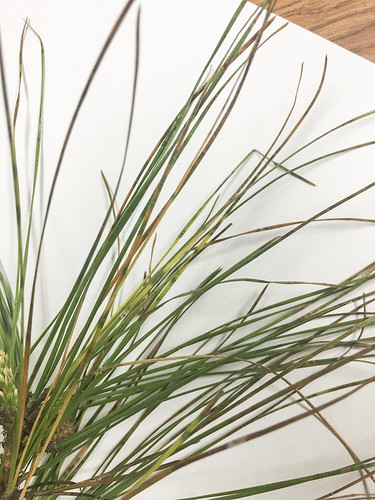By Nick Kordsmeier
U of A System Division of Agriculture
For months, foresters and researchers have been investigating reports of ailing pine trees in Arkansas. New diagnostic lab results help tell part of the story, but researchers are continuing to investigate the cases of loblolly pine decline.
Michael Blazier, director of the Arkansas Forest Resources Center, said that diagnostic results from pine tree samples sent to Auburn University this spring tested positive for the fungal disease brown spot needle blight. Blazier is also dean of the College of Forestry, Agriculture and Natural Resources at the University of Arkansas at Monticello.
While brown spot hasn’t typically been a disease of concern for Arkansas’ predominant pine tree species, the loblolly pine, Blazier said that several years of higher-than-usual levels of rain created perfect climatic conditions for spreading the disease.
Loblolly pine is the most economically significant tree species in the state’s approximately $6 billion forest economy, Blazier said.
“It’s been present more along the Gulf Coast in a different species of pine,” he said, referring to longleaf pine trees. But parts of Arkansas have gotten 200 to 250 percent of average precipitation during the winter-spring period in recent years — perfect conditions for growing fungal inoculum that could spread to loblolly pine trees.
“The prevailing suspicion here is that climatic conditions have been ripe enough for growing enough of it that it would jump over and affect another species,” he said. “Once it had a toehold there, it just kind of feeds itself, and it seems to be spreading across the Southeast.”
The lab results indicating brown spot needle blight are helpful but don’t tell the whole story, said Vic Ford, associate vice president of agriculture and natural resources for the Arkansas Cooperative Extension Service, the outreach arm of the University of Arkansas System Division of Agriculture.
“It tells us that it may be a factor in some locations,” he said. “There are locations with dying trees that don’t have it, and locations with dying trees that have it.”
Ford said that the effects of tree stressors tend to compound each other. For example, he said, trees that grow in wet conditions, like those experienced in recent Arkansas winters and springs, put fewer roots down. When dry conditions follow, fewer roots mean less water intake. The reduced water triggers the tree’s stress mechanism, which includes the production of an aromatic compound called terpenes, which attract insects that further stress the tree.
“Mortality is a function of a lot of things,” Ford said. “There are compounding factors.”
Blazier noted that the diagnostic chemical analyses turned up one other disease — needle cast — and were inconclusive concerning the presence of herbicides.
How did we get here?
Blazier said that forestry consultants first began contacting him this spring, reporting an uptick in dying pine trees in their stands.
“They first brought to me some samples that looked like they had some sort of ailment to it. You could see brown striping on a lot of the needles,” he said.
Blazier explained that pine trees have two sets of needles — older needles from the previous year’s growth and new needles from the current year. Initially, the disease was only affecting the older needles.
“It was the prior year’s needles that were infected at first, and they would brown out and then fall off, so the tree’s kind of left with this ‘Charlie Brown Christmas tree look,’ to borrow an expression from a forester who’s been investigating the forest health problems of eastern Arkansas.”
Soon, when it came time to harvest timber, the forestry consultants noticed that the disease had jumped to the newer needles as well.
“That coincided with an uptick in pine cone production,” Blazier said. “That’s a tell-tale sign that the tree has been triggered to understand that it’s about to die, so it needs to propagate its genetics before it shuffles off the mortal coil.”
Blazier shared photos of the disease with a colleague at Auburn University, Lori Eckhardt, professor and director of the Auburn Forest Health Cooperative. Eckhardt told Blazier the symptoms looked similar to those attributed to brown spot needle blight in Alabama since 2018.
A team of researchers and forestry experts is working to tackle the problem, Blazier said. The team includes members of the Forestry Division of the Arkansas Department of Agriculture, the Arkansas Forestry Association, and the Arkansas Forest Resources Center, which is headquartered at the University of Arkansas at Monticello and conducts research and extension activities through the Arkansas Agricultural Experiment Station and the Cooperative Extension Service, the Division of Agriculture’s research and outreach arms.
Searching for more answers
Blazier said that moving forward, the team is casting a wider net to determine the extent of tree health decline.
“We’re trying to accelerate that pace by using the better technologies of aerial photography and machine learning that help target us a bit better on where we’re sampling and trying to make inferences about where it can be,” Blazier said.
Continued sampling is also part of the plan, he said.
“We plan to continue that through this fall and resume it, starting in February next year, and doing it on a monthly schedule through the summer period,” he said. “By then, we will have had a full year’s worth of seasonal sampling.
“We’re also monitoring the areas that we know have been infested with it to see how those forests will continue to progress,” Blazier said. “There’s some evidence that forests will outgrow it.”
While the trees may display symptoms of pine decline for a time, they may be able to fight it off, he said. “That’s room for hope.”
Sound management is the best policy
Blazier said the evidence so far suggests no need to panic. Instead, he recommends a proactive approach to managing loblolly pine stands.
“Sound management is always the best policy for resiliency against any kind of stressor,” Blazier said. “We don’t want to give up on continuing to manage.”
“It’s not like a wildfire that’s coming across the state fast,” Ford said. “It’s not killing large swaths.
“Hold tight, manage for a healthy stand. In other words, don’t let it get too thick, plant at the right density and those kinds of things,” he said. “You should be able to have a very hard, strong, vigorous stand,” he said.
“If it is going to be a problem, we’re trying to get ahead of it,” Ford said.
In the meantime, experts in Arkansas and across the southeastern U.S. are working to better understand management practices that specifically help mitigate the current instances of pine decline.
“The other thing we’re trying to do is working with industry and these other universities to look for patterns, and where it has been more prevalent, and where it hasn’t been, and trying to understand if there are management strategies that were conducted in some stands that made them less susceptible to it,” Blazier said.
Blazier said that representatives from across the U.S. are gathering at a multi-state meeting in Alabama next month to discuss research efforts on brown spot needle blight in loblolly pine trees.
Homeowners beware
Ford said that if owners of pine trees near homes or other structures observe pine decline symptoms, they should consider taking the tree down.
“A dead tree overhanging your house or access is dangerous,” he said. Ford recommended that tree owners contact their local county extension agent to help them determine the best path forward.
To learn more about Division of Agriculture research, visit the Arkansas Agricultural Experiment Station website: https://aaes.uada.edu/. Follow us on Twitter at @ArkAgResearch. To learn about extension programs in Arkansas, contact your local Cooperative Extension Service agent or visit www.uaex.uada.edu. Follow us on Twitter and Instagram at @AR_Extension. To learn more about the Division of Agriculture, visit https://uada.edu/. Follow us on Twitter at @AgInArk.







